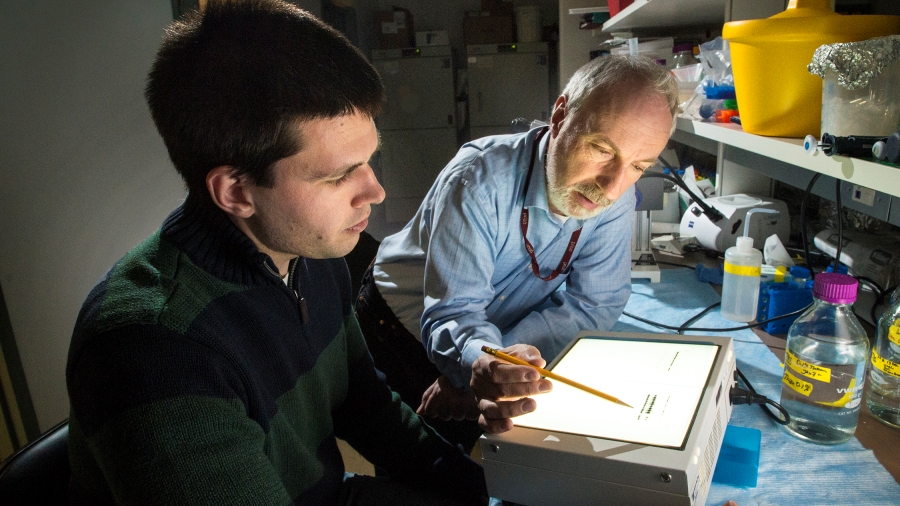
Neurology professor David Westaway (right) and post-doctoral fellow Charles E. Mays collaborated on research that revealed brain cells have a natural defence mechanism against prion illnesses like mad cow disease and Creutzfeld-Jakob disease. (Photo: Richard Siemens)
(Edmonton) New research from the University of Alberta has uncovered a quality control mechanism in brain cells that may help keep deadly neurological diseases in check for months or years.
The new findings "present a breakthrough in understanding the secret life of prion molecules in the brain and may offer a new way to treat prion diseases," said project leader David Westaway, director of the Centre for Prions and Protein Folding Diseases and neurology professor in the Faculty of Medicine & Dentistry at the U of A.
The latest discovery highlights several years of collaborative prion disease research being conducted on an ongoing basis at the U of A, said Westaway.
"The centre involves collaboration with the U of A faculties of medicine and dentistry; science; and agricultural, life and environmental sciences, and is the epicentre of national prion research activities. We are also linked internationally to scientists in the U.S. Centers for Disease Control and Prevention and to the German neurodegenerative disease research network. Through strong research relationships, the University of Alberta and the centre are leading the way in discovery about prion diseases and how to find cures."
Prion diseases lead to incurable neurodegenerative disorders such as Creutzfeldt-Jakob disease in humans, mad cow disease (bovine spongiform encephalopathy) and chronic wasting disease in deer and elk.
The research, published in The Journal of Clinical Investigation, stemmed from two largely unexplained factors for prion infections: their long incubation periods of up to five decades, and a noted time discrepancy between the accumulation of the misfolded rogue prion protein in the brain and when the disease actually shows symptoms.
In probing these mysteries, Westaway, U of A post-doctoral fellow Charles E. Mays, associate professor Jiri Safar of Case Western Reserve University and other international collaborating researchers began two years ago to study a molecule called the "shadow" of the prion protein.
"Dramatic changes in this shadow protein led us to expand our view to include the normal prion protein itself," said Westaway. "This is a crucial molecule in brain cells because it is pirated as the raw material to make rogue prion proteins."
The production of the normal protein had previously received little attention because it was assumed the pipeline to make it was not varying, Westaway noted. There is also an overabundance of the rogue protein that usually complicates detection of the normal protein. But using a special technique to sort the different types of prion protein molecules, Westaway and his fellow researchers discovered a marked drop in the amount of the normal prion protein. Strikingly, this drop occurred months or years before animal models showed conventional telltale symptoms of brain disease.
"Our belief is that the infected cells are smarter than we once thought," Westaway said. "They not only sense the molecular piracy to make the rogue protein, but they also adopt a simple and at least partly effective protective response-they turn down the pipeline of raw material."
Augmenting this natural protective response may be a preferred route to a cure for prion infections, he noted.
"The pre-clinical phase of the disease-before it shows symptoms-is when you want to set things straight. We may be able to take a slow disease and bring it to a complete standstill."
As well, the discovery could assist in understanding other devastating brain diseases, Westaway said. "Since some scientists believe the normal prion protein is an accessory in the brain cell death of Alzheimer's disease, gaining a new understanding of rare yet lethal prion diseases may provoke fresh insights into human dementias."
The researchers' discovery of a natural protective response can also explain the long latency period of prion disease observed by the scientific community studying these infections, he added.
The study was funded by the Alberta Prion Research Institute, Alberta Innovates - Health Solutions, the Canada Foundation for Innovation, the U.S. National Institutes of Health and Centers for Disease Control and Prevention, the University Health Network and the Charles S. Britton Fund.